Power base producers are refining their products for consumers who want life-improving tech, better health and stylish-looking beds
Marketing on the part of both base producers and retailers has raised awareness of the category so that even if, as one manufacturer told Sleep Savvy, consumers don’t necessarily walk into mattress stores intent on buying a power foundation, they are interested in learning more about what they can do.
Enticing them to buy are new high-tech apps that make operating bases easier — and even fun — plus advancements that enhance the lifestyle and health benefits bases offer. As base function continues to improve, so does form. Today’s adjustables are streamlined, with clean lines and furniture-style details like upholstery, fashionable legs and wood veneers.
We’ll look at some of the big trends in the category and give you tips for boosting your adjustable attachment rates.
What more can they add?
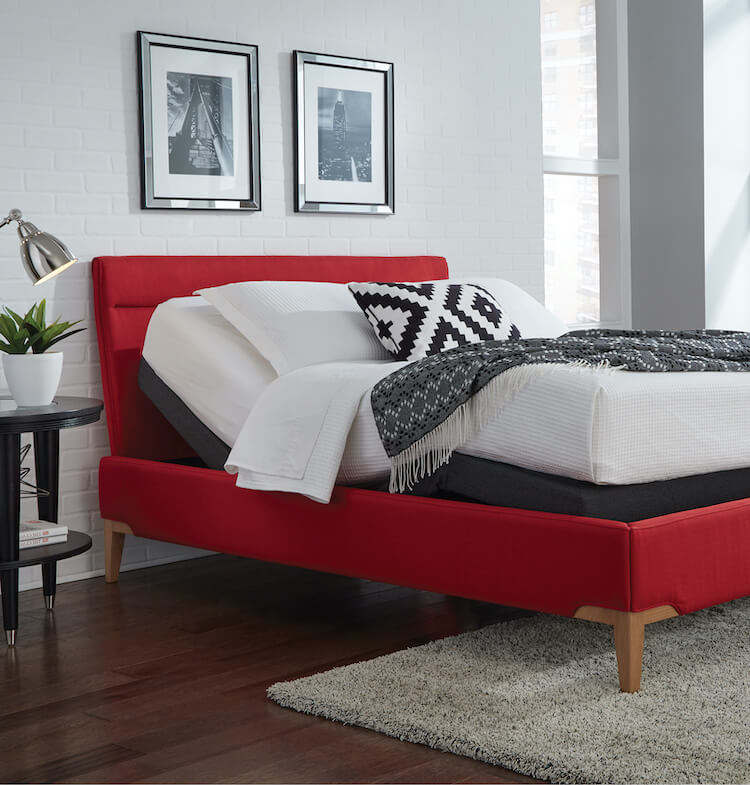
At each new round of furniture markets, power base makers unveil models with even more problem-solving features and high-tech innovations.
Jay Thompson, president of the Adjustable Bed Group of Carthage, Missouri-based Leggett & Platt Inc., says L&P is adding a top model to its Prodigy line in 2020. The Prodigy LBR with Comfort Connect “will be a truly connected bed, offering the user the ability to control home devices and set favorite ‘home scenes’ within the (Amazon) Alexa eco-system.”
“Our proprietary control system takes the memory feature to a new level, allowing the consumer to individualize the home environment by integrating with smart, off-the-shelf devices like door locks, lights and home alarms,” Thompson adds.
L&P has been making adjustable bases for 40 years and its line now includes a wide range bases — from basic, entry-level models to full-featured, high-end bases — with retail prices typically from $599 to $1,999. “While we source materials and finished goods aggressively from low-cost countries, Leggett & Platt’s strength is its robust North American footprint for both manufacturing and distribution,” Thompson says, noting that the company’s other competitive advantages include “short lead times, a broad product offering and competitive price points.”
“We’re always a sleep technology company first, so when we think about any product introductions, we want them to be moving forward technologically,” says Lisa Tan, chief marketing officer for Reverie, an adjustable base maker in Bloomfield Hills, Michigan. “We pride ourselves on our ability to innovate and provide technological features at every price point, from the entry level to our premium products.”
The company’s eponymous Reverie line contains six models, including the popular R400 with head and foot adjustability and massage at a “velocity price point” of $1,200, Tan says. The step-up R450 HT ($1,499) adds head tilt for people who like to lie in bed and read. The top of the Reverie brand line is the R650, which features 3D Wave massage and an extra motor to provide all-bed tilt ($1,999).
“You can tilt the entire base backward or forward,” Tan says. “It’s a unique experience and a really cool feel, a little like floating in space.”
The Reverie Nightstand app allows sleepers to control bases with their smartphones instead of remote controls, and in October, the company started rolling out to retailers Reverie Connect, a voice-activation technology that can be used with Amazon Alexa and Google Home.
“We’ve worked with Google to be a Google Skill,” Tan says. “So, instead of saying, ‘Hey, Google, tell my Reverie base to move to zero gravity,’ you can just say, ‘Move bed to zero gravity.’ Or you can set a bedtime skill (in a connected bedroom) so that when you say, ‘It’s bedtime,’ the lights are going to dim, your Nest thermostat is going to go down to 70 degrees and the base’s massage feature will start for 20 minutes — or whatever you want it to do. It’s a technology that allows people to live super comfortable lives that are optimized and run efficiently.”
Sleep products maker Malouf tries “to be pretty aggressive on price, but technology is what we spend a lot of our time and energy on,” says Scott Carr, marketing director for the Logan, Utah-based company.
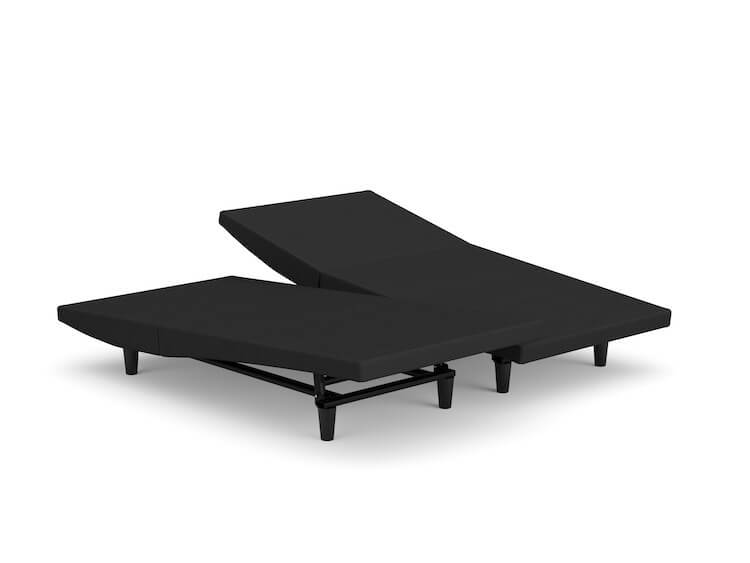
Malouf offers a seven-model power foundation line. Its newest base, introduced in July, is the E255, which features an upholstered frame with wireless remote and three preset positions: zero gravity, anti-snore and flat ($500). “It’s very sleek, foldable for easy shipping and has quite a few upper-end features,” Carr says.
The top adjustable in Malouf’s line is the S755 ($2,000). “It’s the granddaddy of them all, with all the bells and whistles,” Carr says. Those bells and whistles include 12 dual-zone massage options, five preset positions, six programmable positions, Bluetooth compatibility, head tilt and lumbar support.
Malouf’s in-house software developers created the Malouf Base smartphone app for iOS and Android that works with the four top models in the company’s line so sleepers can control and program functions without using a remote.
“You can program it to do what you want and it has Siri shortcuts, so, if your partner’s snoring is a repeated problem, you can say, ‘Hey, Siri, help a girl out’ and the bed will adjust,” Carr says. “Consumers, in general, are expecting more connected experiences and easy access to technology through their phones.”
Customatic Technologies started out more than a decade ago as Customatic Adjustable Bedz but changed its name to better reflect its focus on advanced technologies and customized products.
“We’re constantly pushing the envelope with new technologies,” says Phil Sherman, president of the Natick, Massachusetts-based company. “That’s why we have so many patents. I think people come to us for uniqueness. That’s how we set ourselves apart: being the company that creates better products with higher profit margins.”
The company offers a half-dozen adjustable base styles, but all can be adapted and customized for retailers that want private-label lines, Sherman says. Two popular Customatic models include the Galaxy and FeatherLite. Depending on which features are included, they retail from $499 to $999.
Customatic is exploring artificial intelligence to solve some consumers’ sleep problems and plans soon to launch an anti-snore technology it calls SnoreTech. Without divulging proprietary details, Sherman says SnoreTech monitors biorhythms and automatically elevates the mattress when it detects snoring, all without wearable tech or audio devices.
“It’s something brand new,” Sherman says. “It can automatically adjust to conditions without consumers having to do anything. We find that consumers want their problems solved without effort on their part.”
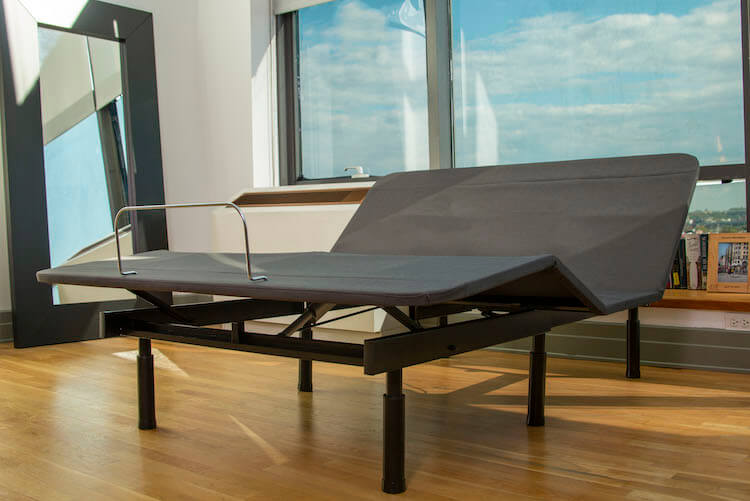
W. Silver Products offers a full array of features in its line of seven Silver and Gold series adjustable bases, with prices starting at $599 and topping out at $1,299. “We don’t go as low as some folks or as high as some folks. We’re in the meat of the business,” says Brent Polunsky, sales manager for the El, Paso, Texas-based company. WSP’s GS71, the top end of its line and one of its best-selling models, has head and foot adjustability; zero-gravity, lounge and TV positions; variable speed massage with wave and pulse motions; LED underbed lighting; USB ports; and programmable presets, among its many features.
The company, originally a maker of steel bed frames and rails, added adjustables under the Comfort-n-Motion brand to its line several years ago. Initially, WSP imported bases but then moved production to Juarez, Mexico.
“We build the sub-assemblies, cut foam, cut fabric and do our own testing — load bearing, cycle count testing, etc.,” Polunsky says. “We can turn on a dime. We can walk out into the factory, make a change and start delivery in a week.”
“Retailers should feel comfortable that the base they buy from us has been made by us and tested by us,” he adds. “It’s going to last and we’re going to stand by it.”
Getting to “AAh”
“If you can get someone into the presentation phase of an adjustable base, you’re pretty much there in terms of sales,” says Phil Sherman, president of Customatic Technologies, with headquarters in Natick, Massachusetts.
As shoppers lie on a bed with an adjustable base, elevate their heads, raise their legs a bit and turn on the massage. As you demonstrate various features, watch for their reactions. Do they relax? Settle in? Do they say, “Aah!”
“When I get them into a position they love, I say, ‘Close your eyes for 60 seconds.’ If they’re willing to do that, you know you’ve gained their trust,” Sherman says. “Then let them relax.”
It’s the next step that can help close the sale. “Turn off the massage, and lower the head and foot,” he says. “By comparison, they’ll feel like they’re now lying on a flat board. That’s when you ask them, ‘Now, wouldn’t you prefer to sleep on the adjustable?’ ”
Healthy sleep and better lives
The adjustable bases sold by today’s mattress retailers trace their roots to hospital beds. To overcome that association in a retail setting and expand the market, for many years, manufacturers and retailers focused on the lifestyle benefits of power foundations, such as easier reading, working and watching TV in bed. Those still are selling points, but producers and retailers are more comfortable touting the fact that power bases — now with their medical origins hidden by sleek design — can help people alleviate health problems, including sleep apnea, edema and back pain.
Innovations such as whole-bed tilt can help athletes needing post-workout recovery, as well as people who spend time in bed because of serious health issues, Tan says. And technology like hands-free, voice-activated Reverie Connect paired with a feature-filled base is ideal for people who have limited mobility from conditions ranging from quadriplegia to multiple sclerosis to cerebral palsy, Tan says. “It’s crucial for them to be able to move and shift positions throughout the night,” she says. “Voice activation with an adjustable base can help people live healthier, better lives.”
Polunsky adds: “You can really build value by showing the health benefits of an adjustable base. I’m always cautious not to say they cure conditions, but they can help.”
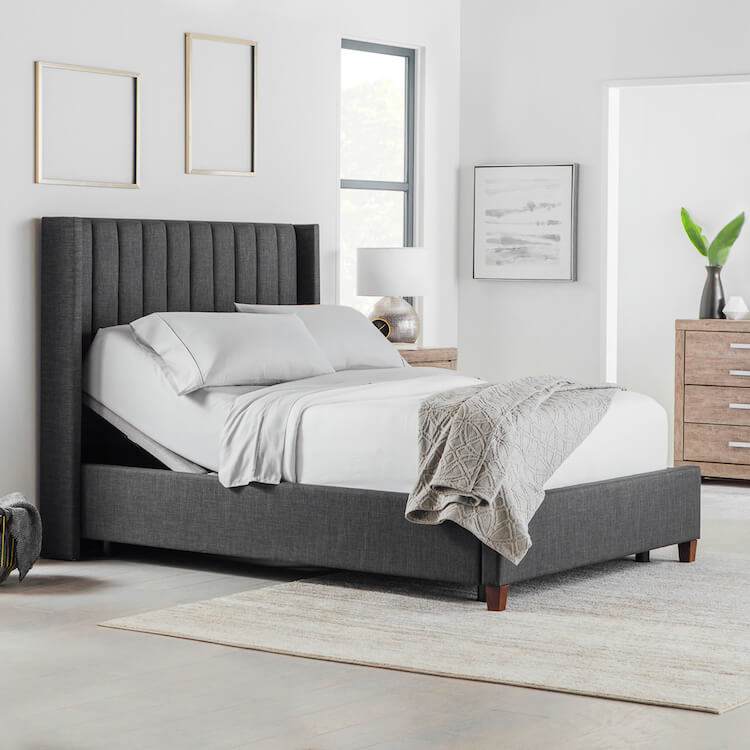
Transfer Master Products, an adjustable base maker headquartered in Postville, Iowa, specializes in producing beds for the medical market, particularly for rehab facilities, and uses that expertise to make the Supernal line for retail. Supernal models look less like hospital beds than the company’s core products but still are aimed at baby boomers and consumers of all ages with disabilities or other medical conditions, says Aaron Goldsmith, president of the company.
“With Supernal, we moved the image of our bed from a medical product to a piece of furniture that has accommodations for people with special needs,” he says. “We’ve positioned ourselves to target the baby boomers and people who have obvious health problems,” such as mobility issues that require use of a cane, walker or wheelchair.
“If someone says, ‘I can only sleep in my recliner’ or says, ‘My wife has pulmonary issues, edema or terrible arthritis’ — those are my customers,” Goldsmith adds.
The Supernal 3, best known as the Supernal Hi-Low, lowers and raises to allow people to get in and out of bed more easily. It also features head and foot adjustability, head tilt, variable massage settings, wall hugging capability and a simplified backlit wireless remote for easy nighttime use. The Supernal 5 adds whole-bed tilt and reverse tilt. Both models come with optional side rails and vinyl mattress covers.
The Supernal 3 retails for $3,000 in twin size and the Supernal 5 for $4,000 in twin. “I make a living disproving everybody else out there who tells me our beds are too expensive,” Goldsmith says, noting that, as a niche player, his goal is not for his products to take over the floor of every mattress retailer but to be an option for those consumers who can benefit from the Transfer Master expertise and designs.
“I don’t want anyone to take out their entire existing adjustable line to sell Supernal, but (our research shows) one out of five people has a disability or takes care of someone with a disability,” he says. “For that customer, Supernal is the best option.”
Send it anywhere
Every part of the bedding business has been impacted by e-commerce and the rise of direct-to-consumer retailers. The adjustable segment is no exception, with manufacturers adding boxed, easily shippable models that can be sold direct to consumer via e-commerce or as a cash-and-carry item through brick-and-mortar retailers.
Soon, there will be more lightweight, shippable bases on the market.
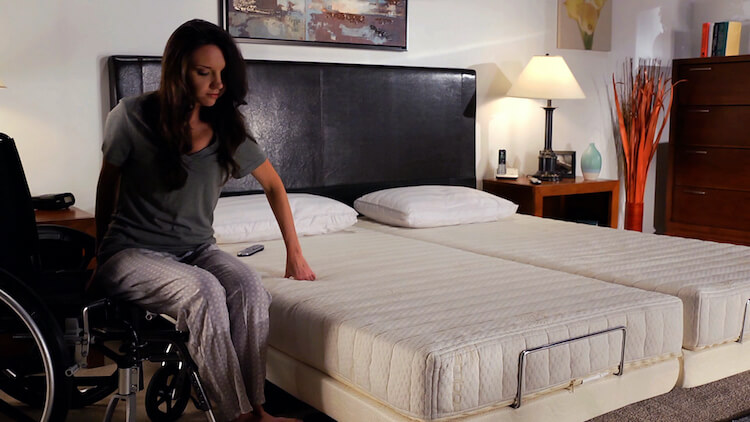
L&P will roll out several new adjustables during the Winter Las Vegas Market, including the “parcel-friendly” Symmetry collection of ultra-low profile, platform-friendly bases, Thompson says. “With retail price points well under $1,000,” he says, “we think these models will appeal to furniture stores, sleep shops and e-commerce retailers.”
Next year, Customatic expects to introduce a king-size adjustable base that will be compact and lightweight enough to ship as a small parcel via carriers like UPS and FedEx.
“One of the newest, coolest items we’re doing are the Complete Sleep adjustable mattress and base packaged in one shippable box,” Sherman says. “We thought, ‘If boxed mattresses are successful, why wouldn’t a mattress and adjustable base together do well?’ ” The Complete Sleep package retails from $899 to $999.
And in the coming year, Transfer Master expects to introduce Supernal 2, a boxed version of its adjustable base. “It’s going to be price-sensitive but certainly not the cheapest,” Goldsmith says. “It will be reliable and competitively priced for a quality mechanism and bed.”
Logicdata, which specializes in motion furniture, “takes a different approach to the (adjustable base) market by focusing on offering high-quality adjustable bases with packaging optimized for shipping,” says Dexter Weber, sales and marketing manager for the company, which is based in Deutschlandsberg, Austria, with U.S. headquarters in Grand Rapids, Michigan. “Our adjustable bases are made to be UPS/FedEx shippable without the need to pay oversize fees. This makes our product perfect for e-retailers and retailers with an online presence, as well as retailers that want to offer adjustable bases that a consumer can take home in their vehicle and set up easily themselves.”
The vertically integrated company produces its own components, including actuators, remotes, control boxes and power supplies, “giving us the advantage of having a complete system where every single piece is made specifically to work perfectly together in a unique design optimized for shipping,” Weber adds.
The company’s SILVER series includes the SILVERstandard and the SILVERlite. The SILVERstandard has “a clean, modern European design” with control features built into the side rails to make room for underbed storage. In addition to head-up and foot-up positioning, it includes USB ports, underbed lighting, memory positions and optional massage among its features. It retails from $1,200 to $1,500.
Earlier this year, Logicdata launched SILVERlite “with the smallest packaging on the market,” Weber says. Its features include head-up and foot-up adjustability, memory positions and underbed storage ($800-$1,000). “This adjustable base is ideal for e-commerce customers, as well as customers living in big cities,” Weber says. “The small packaging and ready-to-assemble design makes it easy to move up or down stairs, through narrow hallways, into elevators and into smaller apartments.”
Where’s the Remote?
If you can’t find the remote while watching TV at home, it’s frustrating. If you can’t find the remote while trying to demonstrate an adjustable base, it can mean losing a sale.
“I walked into a retailer this summer and asked to see a power base. The RSA brought out a box of remotes, maybe 20 of them, and just started pressing buttons until he saw a bed move,” says Lisa Tan, chief marketing officer for Reverie, an adjustable base producer based in Bloomfield Hills, Michigan. “I felt bad for him because it’s hard to keep track of all the mattress models and bases, but it didn’t make a strong sales presentation.”
To avoid such problems in your store, have retail sales associates get in the habit of returning remotes to the same location on each bed (ideally a pocket on the base itself). And double-check at the start of every day that each remote is paired with the right base.
Pro tip: Also keep a supply of batteries on hand and replace all batteries regularly. A dead battery won’t help close a sale.
Form matters, too
The newest adjustables bases are like the newest smartphones: thin and sleek. With many younger consumers preferring the look of platform bases over the more traditional headboard and footboard, base makers are offering options that fit neatly into both settings, as well as models that stand alone.
Reverie’s R550 base features a wood veneer on the lower deck. “It’s a very attractive base if you want to use it without bedroom furniture,” Tan says. The step-up R550L offers additional lumbar support.
“Today, it’s all about making a statement,” Sherman says. “As the paradigm has changed from hospital bed to lifestyle base, the appearance has changed from something antiseptic to something with more design flair.”
Customatic’s new Magellan foundation, introduced at the Summer Las Vegas Market, sits upon designer legs and comes with coordinating headboard and attachable nightstands ($1,299). It’s more than an adjustable base, Sherman says, it’s a fashionable bed.
“Part of our design process is thinking, ‘How do we glamorize the adjustable base? How do we make it a fashion statement as opposed to just a functional base?’ ”
Expanding price points
As the adjustable category has grown, producers say, it has experienced some of the same frustrations that affect mattresses, including growing competition from imports, downward pressure on prices and a commoditization of the category.
“Over time, for some retailers, it has become less and less about the design of the product or the integrity of the product and more about the price,” Sherman says, pointing in particular to the trend of retailers offering “free adjustable base with purchase” to increase floor traffic.
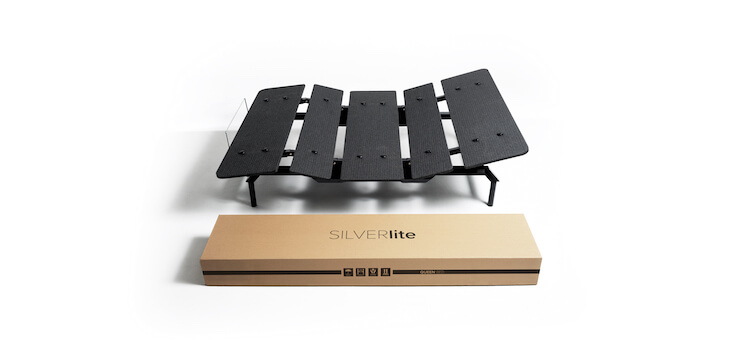
“I’m not opposed to that as long as retailers understand how to do it,” Sherman says. “If they want to offer a head-up-only basic base free with mattress purchase, I’m not opposed to it as long as the sales associates are explaining all the things a full-featured adjustable base can do: the underbed lights, the USB ports, the massage, etc. So, maybe if you offer head-up-only base for free, you get consumers interested in what an adjustable is. But then ask, “ ‘How can I elevate the story and get them interested in something that will give them more benefits and satisfaction?’ ”
Thompson notes that while price points have dropped, many consumers are getting “more for less.” One of L&P’s best-selling power bases is the Simplicity HFM, which comes with a capacitive touch remote, dual charging ports and an 850-pound lift capacity. Another key feature: a “velocity price point below $750,” Thompson says.
“As technology advances and the product category scales, features have improved at a lower cost,” Thompson says. “This has been an important driver of growth, and many retailers have seized the opportunity to embrace the product category that is now more feature-rich and affordable.”
To meet demand for a broader range of price points, this past spring, Reverie introduced a lower priced line called OSO by Reverie.
“About two years ago, we started seeing an inundation of lower price points hitting the market and we had to get into that segment without sacrificing quality,” Tan says. “The advantage to the lower priced line is more people can afford to sleep on an adjustable base.”
The starting OSO by Reverie model, the O200, is the type of head-up model that many retailers use as part of their “free base with purchase” promotions, Tan says. The five models in the line step up from there to the top model in the group, O400T, which has head-up and foot-up capabilities, along with programmable positions. Prices for the OSO by Reverie bases, all of which are foldable and shippable for e-commerce sales and easy delivery, range from $599 to $999.
Polunsky says W. Silver Products’ retail dealers always are seeking lower prices, “but they don’t want junk. They are looking for something they can feel comfortable selling that’s going to last.”
Weber says that desire extends to consumers: “There is a lot of talk about the lowest cost, but consumers are willing to pay more if they see the value in a more expensive adjustable base.”
How Do You Rate?
How many mattresses that you sell go out the door with an adjustable base?
Attachment rates vary widely, with some retailers averaging 10% or so, but others enjoying a more robust 30%, says Scott Carr, marketing director for Malouf, a sleep products maker in Logan, Utah.
“Forty percent is a good target,” says Brent Polunsky, sales manager for W. Silver Products in El Paso, Texas. “If, as an industry, we can hit 40%, that would be a good number.”
Lisa Tan, chief marketing officer for adjustable base maker Reverie in Bloomfield Hills, Michigan, wants retailers to aim a little higher. “Let’s go for 100%,” she says. “But seriously, we have some really cool technology, even in promotional bases. We should be able to get average attachment rates over 50% at some point.”
Tips for Selling More and Better Bases
Refine your lineup. The exact number of adjustable base models a store should carry will vary from retailer to retailer, but most should offer a basic head-up or head-up/foot-up model. “And then think about step-ups from there that will make sense to customers,” says Lisa Tan, chief marketing officer for Reverie, an adjustable base producer in Bloomfield Hills, Michigan. “For instance, massage is an obvious step-up: Customers who want it will pay for it.” A selection of three to five differentiated bases works well for most retailers. For demonstrations, some manufacturers recommend starting in the middle of your lineup and moving to higher or lower priced options, based on customer feedback. “Retailers need to highlight the features of each adjustable base to show the consumer what the differences are between models so they can understand which features and which price points fit their needs,” says Dexter Weber, sales and marketing manager for Logicdata, which is based in Deutschlandsberg, Austria, with U.S. headquarters in Grand Rapids, Michigan.
Cover your bases. It’s not surprising that makers of adjustable bases suggest retailers put one under every mattress on the showroom floor, but there is a logic to the recommendation. After shoppers have settled on a mattress, it can be jarring to then have them move to another mattress — one they might not like as much — to experience a power base. “The more you have on your floor, the better chance you have of selling these bases,” says Brent Polunsky, sales manager for W. Silver Products in El Paso, Texas. “It’s easier to pivot the conversation over to the lifestyle base if they’re already on a base that moves.” For some retailers, it’s not practical to put an adjustable base under every mattress. In those cases, place power bases under your best-selling mattresses, manufacturers suggest.
Show them to everyone. If you don’t consider every customer a potential purchaser of an adjustable base, you’ll limit sales and shortchange people who might benefit from the product. “You have to show adjustable bases to every customer,” Polunsky says. (To read more about a retailer who takes such advice to heart and has great success selling adjustables, check out the July/August Retail Road Trip on Riley’s Furniture and Mattress at SleepSavvyMagazine.com/Rileys-Furniture-Mattress.)
Put them in motion. “We suggest displaying a couple of bases with the head up so that they catch people’s attention when they’re walking through the showroom,” says Scott Carr, marketing director for Malouf, a sleep products manufacturer based in Logan, Utah. “It can start the conversation naturally without an RSA always having to bring it up.”
Listen to your customers. If you’re attentive to what they’re saying, shoppers often will give you natural openings to introduce adjustables. For instance, if they’ve said they suffer from back pain, show them the relief they can get from a lumbar feature. On their feet all day at work? They’ll probably appreciate the
zero-gravity position. Many couples report that one partner snores. That’s the time to demonstrate anti-snore presets. You might not only sell a bed set, you might save a relationship!
Improve your online sales tactics. “Retailers need to be flexible. The buying patterns for consumers is shifting due to the huge influence of the internet,” Weber says. “Some customers want to purchase online out of convenience. In this scenario, retailers want to have a great description and suggestive selling when their customers are ordering other products.”
Price them right. Price each adjustable-friendly mattress with both a flat foundation and at least one power base. Such a practice gets shoppers thinking about adjustable bases as a financially feasible option rather than an add-on. It also makes it easier to ask for the sale in the way that Polunsky suggests: “You’ve already picked your mattress. Would you like that on a flat foundation or a power foundation?”






